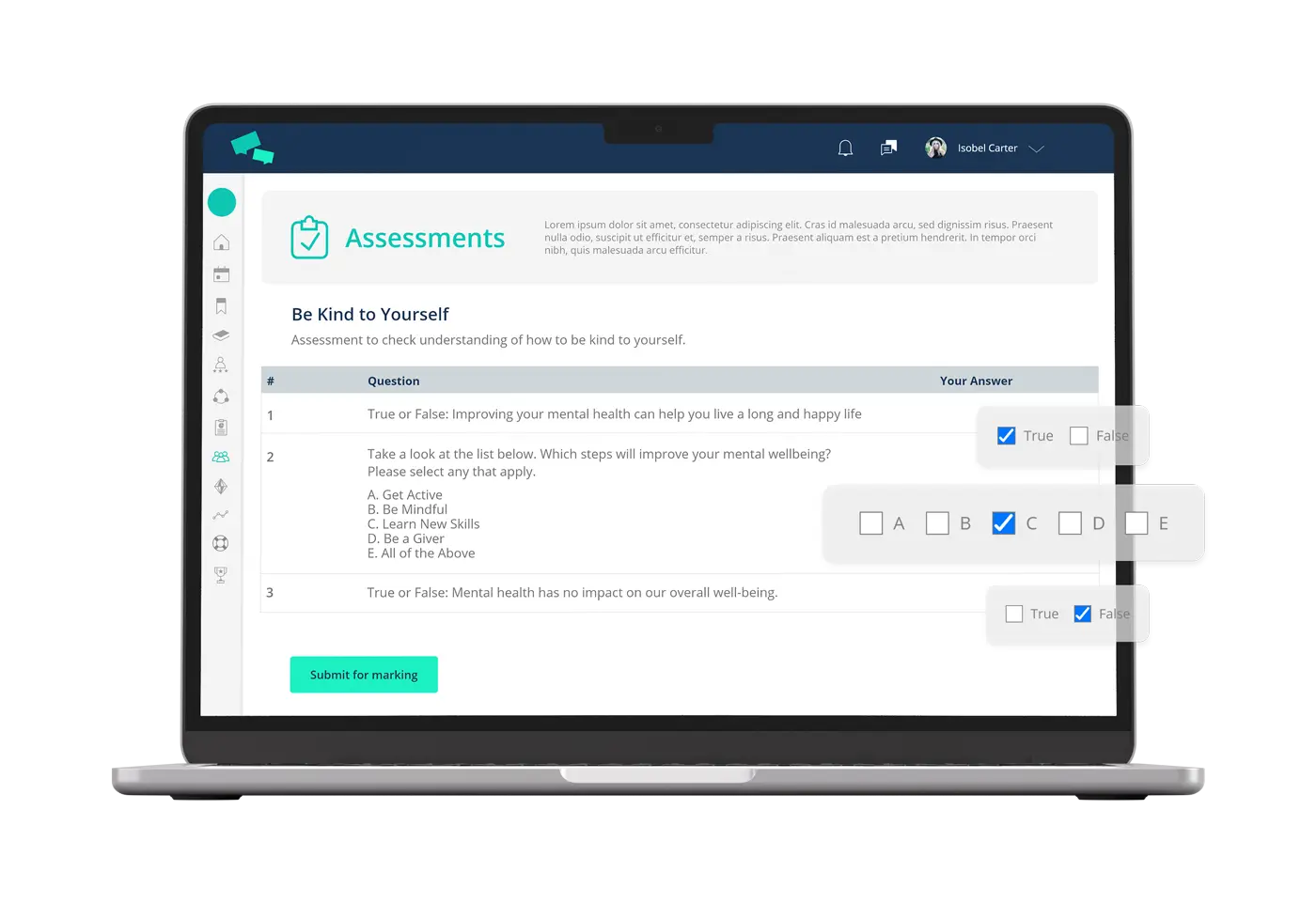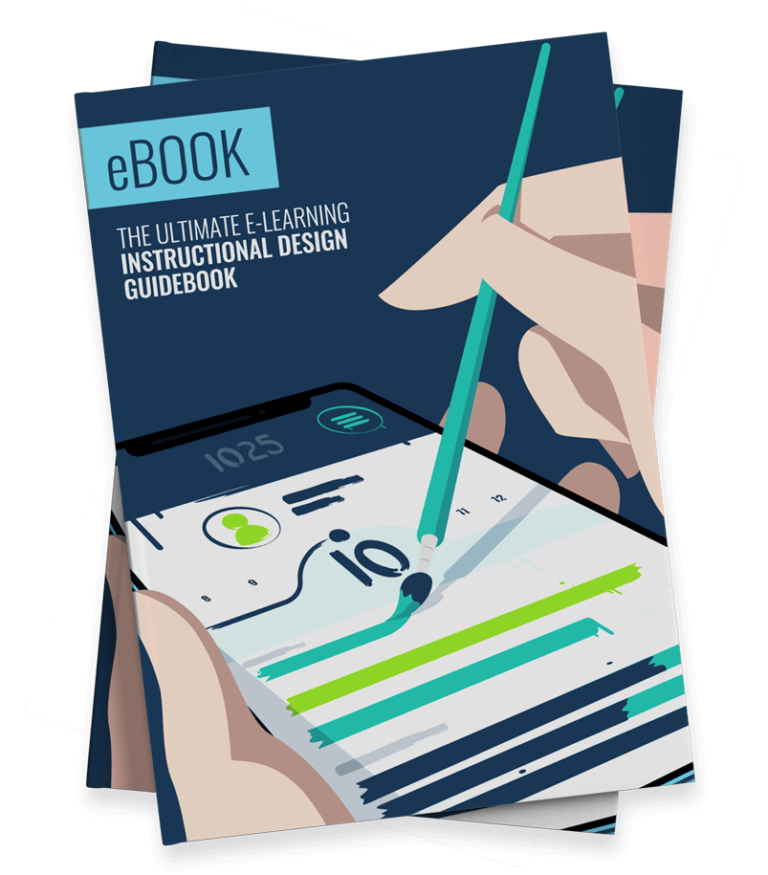
Ah, the humble quiz. It’s a tool that keeps our brains sharp, tests knowledge and can even spark some friendly competition. Quizzes and assessments, when used effectively, can be powerful learning resources.
Our brains love a good challenge. Trivia sites like Sporcle and BuzzFeed Quizzes remain hugely popular. Game shows like Jeopardy! and Who Wants to be a Millionaire have been captivating audiences for decades.
What’s more, according to YouGov, pub quizzes are the 20th most popular social activity. For those who are wondering, that’s just below looking after somebody else’s puppy.
So, why is it that this love rarely transfers over into the world of workplace learning and development (L&D)? Quizzes are commonplace. After all, we’ve all suffered through our fair share of end of unit knowledge tests. But why do they feel like such trivial pursuits?
In many cases, this is due to poor design choices. Quizzes are often plagued by unclear questions, irrelevant content and a lack of meaningful feedback. Is it any wonder that learners often feel discouraged rather than engaged?
Crafting effective quiz questions is an art form that requires a careful balance of clarity, challenge and intrigue. With this in mind, we’ve created the ultimate guide for quiz-building, complete with 20 practical tips.
Get ready to unleash your inner quiz master!
What is a Quiz?
Let’s start with a simple definition.
Quizzes are typically a quick knowledge check that tests specific skills or knowledge. They often use multiple-choice, true/false or short answer questions. This differs slightly from assessments, which offer a broader and more comprehensive evaluation of your learners.
Quizzes can be used for formative assessment (providing feedback to guide learning) or low-stakes summative assessment (checking understanding of learning). They’re often applied at the end of eLearning units to serve this summative purpose.
The Role of Assessments & Quizzes

Ever heard of the testing effect? This powerful learning principle suggests that actively retrieving information, as you do when completing a quiz, strengthens your long-term memory more than simply re-reading material.
Harvard psychologist William James summed up this phenomenon at the end of the 19th century: ‘A curious peculiarity of our memory is that things are impressed better by active than by passive recollection… it pays better to wait and recollect by an effort from within, than to look at the book again’.
In fact, research suggests that you will recall 50% more information by testing yourself than by using the same amount of time to study. Take that, forgetting curve!
As cognitive psychologist Jeffrey Karpicke notes, ‘Recalling information we’ve already stored in memory is a more powerful learning event than storing that information in the first place. Retrieval is ultimately the process that makes new memories stick.’
Clearly, quizzes and assessments offer much more than a quick test of knowledge or skills. They’re integral parts of any meaningful learning journey. Here’s how they contribute to effective learning.
- Solidifying Knowledge: As we’ve seen, quizzes don’t just check knowledge. The act of retrieving information helps to strengthen memory pathways and promote long-term knowledge retention aided by spaced repetition.
- Identifying Gaps: Your quizzes also help to identify areas where learners might be struggling. As a result, you can adjust your instruction, provide targeted support and ensure that everyone is able to make progress.
- Promoting Engagement: A well-designed quiz can also help to boost engagement levels. After all, they encourage learners to re-engage with concepts and provide ample opportunities for reflection and progress tracking.
- Feedback Engines: By offering targeted feedback (on each question or the entire quiz), your quizzes become interactive learning experiences. In turn, this helps your learners to better understand their strengths and weaknesses.
The Impact of Quizzes
Now we know that quizzes aren’t just there to check knowledge and frustrate your learners, let’s dig into the research around their impact on learning outcomes.
Take this 2020 Iowa State University study, for instance. Their results suggest a ‘strong link’ between frequent quizzing and student success. Here’s what researcher Marcus Crede had to say:
‘I was sceptical. I didn’t think this would have much of an effect… The effect of quizzes was relatively strong. The odds of passing a class went through the roof where instructors used this. A modest effect can have a large impact over the course of many years.’
There’s plenty more evidence to back this up. For instance, this 2021 meta-analysis of 222 independent studies shows that quizzing improves ‘long-term retention’ and ‘mastery of new information’ due to increased levels of exposure and motivation.
Furthermore, this University of Texas study from 2013 shows the kind of impact that frequent quizzing can have. In fact, where daily quizzes were used students performed on average half a letter grade better than their comparison group.
Surprisingly, these students even performed better in their other courses. This suggests that regular quizzing makes preparedness contagious.
Setting the Foundation for Your Quiz
Forget winging it. Just like so many other elements of your training programme, crafting a good quiz requires a solid foundation. Two key elements pave the way for effective assessments: clear objectives and a good understanding of your audience.
Step 1: Align With Your Learning Objectives
Creating a quiz without a clear set of learning objectives is a recipe for confusion. This will leave your learners wondering what they’re supposed to be learning (and you wondering what they’re supposed to be remembering!).
To avoid this pitfall, start by defining your training programme’s overall learning objective. If necessary, break this down into smaller, more manageable sub-goals. This will make it much easier to create questions that assess whether these objectives have been achieved.
For example, if a learning objective states that ‘Learners will be able to name the six stages of Bloom’s Taxonomy’, then your quiz questions should directly test this, instead of asking about the history of instructional design.
Step 2: Get To Know Your Audience
Understanding your audience is vital for crafting questions that resonate with them. This will ensure your questions are not overly simplified or so complex that they discourage participation.
For instance, you’ll want to consider their existing knowledge and any learning preferences they might have. Do they prefer visual aids, hands-on activities or theoretical discussions? These factors will help you to tailor the difficulty level of your questions accordingly.
What Question Types To Use

Once you’ve achieved a solid foundation, you’ll be ready to start building your quiz. At this stage, you have a variety of question types available to you, each with their own strengths and weaknesses. Here’s a breakdown of some common formats:
- Multiple Choice: This is the most popular question format, presenting learners with several answer options for them to select from. Multiple-choice questions are versatile, easy to complete, and can test a range of knowledge levels.
- True / False: These questions are simple and straightforward, asking learners to identify whether a statement is true or false. They’re low effort and good for testing factual knowledge, but somewhat limited in scope.
- Mix & Match: This question type requires learners to match items from one list to another based on a specific relationship. For instance, matching food items to different food groups. They’re useful for testing associations between concepts.
- Fill in the Blank: These questions test recall of information by presenting a statement with a missing word or phrase. For instance, ‘The smallest unit of matter is called an ____.’ They’re good for assessing definitions or key terms.
- Short Answer: This approach asks learners to answer a question in a concise written response, often with a word limit applied. They’re great for encouraging critical thinking, but grading them requires a human touch.
- Essay / Assignment: This is the most open-ended question format, requiring learners to develop a well-structured written response. Essays encourage analysis and evaluation, but are time-consuming for both the learner and the assessor.
- Scenario-Based: This interactive question type presents learners with a realistic scenario and asks them to apply their knowledge to propose a solution. They encourage problem-solving, but can be costly and time-consuming to create.
- Drag and Drop: This format, common in eLearning modules, challenges learners to drag and drop answer choices to designated areas. They’re engaging and visually appealing, but their use case is somewhat limited.
Whilst these question types form the core of most standard tests or quizzes, there are many more to select from. For instance, there are also a variety of image-based questions, scale-based questions and questions that require a calculated numerical answer.
20 Tips for Crafting the Perfect Quiz
As you’re building your quiz, you should take care to ensure it’s fun, engaging and informative. To support you in your quest, we’ve collected 20 tips that will help you to both assess learning effectively and create an enriching learning experience.
- Provide Clear Instructions: Start out on the right foot, by beginning your quiz with clear and concise instructions. Explain what you’re assessing, how your quiz will be scored, any time limits, and any possible gamified rewards.
- Embrace Accessibility: Consider accessibility features for learners with disabilities. This could include options for screen readers, adjustable text size, or alternative question formats. Even using clear and contrasting colour schemes can make a difference.
- Keep it Varied: We recommend incorporating a variety of question formats to stave off monotony. A sea of multiple-choice questions might leave your learners feeling adrift. Consider using visuals or multimedia elements to enhance engagement.
- Pick Your Purpose: Match your questions to your mission. Don’t ask your learners to write a full essay if you’re simply checking their recall of key facts. That would be a waste of their time and yours.
- Limit Your Answers: It’s easy to fall back on multiple-choice questions, just make sure you don’t give your learners too much choice. As noted below, this can lead to the negative suggestion effect. The sweet spot is between 3-5 potential answers.
- Avoid Trick Questions: Strive for clarity over confusion. Questions should test knowledge, not reading comprehension or the ability to decode convoluted wording. Remember, you’re trying to promote retrieval practice, not catch your learners out.
- Stay Positive: Quiz questions are often rife with negative phrasing and double negatives. Questions like ‘Which of the following is not a characteristic of effective leadership?’ can leave learners untangling your meaning rather than focusing on the content.
- Keep it Simple: In general, keep your questions and answers concise and ensure they’re easy to interpret. Avoid using jargon, slang or other technical terms that haven’t been properly explained during your training programme.
- Ensure Plausibility: Create plausible multiple-choice answers. Resist the urge to throw in funny or obviously wrong answers. These weak distractors do little to challenge learners’ critical thinking skills or test their recall.
- Use Quality Distractors: Instead, focus on crafting plausible distractors. These are answer choices that are incorrect, but seem like reasonable options based on the question stem. As a result, your learners will be forced to analyse each option carefully.
- Randomise Question Order: If you have a quiz that may need to be retaken, then prevent your learners from memorising the order of answers based on their previous attempts. Randomisation keeps the quiz fresh and fair.
- Test Application: Don’t just test recall. Include questions that require learners to apply their knowledge in real-world scenarios. This engages their critical thinking and problem solving faculties, often leading to deeper levels of understanding.
- Balance The Difficulty: Ensure your questions are difficult enough to challenge your learners, but not so difficult that they get discouraged. We also recommend using a mixture of easy, medium and hard questions to keep learners engaged.
- Provide Feedback: Don’t leave your learners hanging! Your quizzes are the perfect mechanism to provide timely feedback. Offer clear explanations for both correct and incorrect answers to help learners solidify their understanding.
- Gamify Your Approach: Learners not engaging with your quizzes? Consider incorporating game mechanics like experience points, badges and leaderboards to add a fun and competitive twist to your tests and assessments.
- Make it Social: Adding collaborative elements like team quizzes or discussion forums helps to foster a sense of community and shared learning. You could even use Knowledge Contests, now available on Growth Engineering LMS.
- Use Timers: Depending on the complexity of your content, you may wish to add a reasonable time limit to your quiz. This should prevent learners from seeking out answers from elsewhere, whilst simultaneously creating urgency.
- Reduce Anxiety: Learning should be a positive experience, and quizzes shouldn’t feel like an ordeal. Focus on creating a supportive learning environment where learners feel comfortable taking risks and making mistakes.
- Proofread Your Quizzes: Typos, grammatical errors, or unclear wording can all lead to frustration for your learners. Even worse are factual errors or contradictions within your training materials. Always perform a quality check on your quizzes.
- Seek Feedback: Just like any other part of your learning programme, your quizzes can always benefit from improvement. The best way to identify areas for growth is to gather feedback directly from your learners.
In a nutshell, clarity and variety are the key. Align your questions with your learning goals, mix up your formats, and provide clear explanations. This winning formula will ensure a positive learning experience for everyone involved.
You should also be wary of the negative suggestion effect. As Washington University professor Andrew Butler puts it: ‘The fact that multiple-choice tests expost test-takers to a lot of incorrect answers is worrisome, because they could potentially learn it.’
This is why it’s important to provide meaningful feedback, regardless of your learners’ answers. Correct responses offer a chance to reinforce understanding, while incorrect answers present a valuable opportunity to guide learners in the right direction.
Examples of Good & Bad Questions
To help you put these principles into practice, we’ve shared some examples of good and bad quiz questions below. Notice how the good examples are clear, concise, and leave little room for misinterpretation. The same cannot be said for the bad examples.
| Good Example | Bad Example |
| What is the capital of Germany? | Which of the following cities might be the capital of Germany? |
| Select all of the factors that contribute to climate change. | Not all of the above factors contribute to climate change (choose all that apply). |
| What is the most common greenhouse gas? | What is one of the most common greenhouse gases? |
| Which scientific theory originally proposed that the Earth was at the centre of the solar system? | Which scientific theory did not propose that the Earth revolved around the sun? |
| Which of the following events is most directly associated with the start of World War I? | Which of the following events could be said to have started World War I? |
| The smallest unit of matter is called an ____? | The smallest unit of matter is not called an ____? |
Final Words
Quizzes are a cornerstone of learning and development programmes. They assess knowledge, identify learning gaps, and can even motivate your learners. However, poorly designed quizzes can be frustrating and counterproductive.
To create engaging and impactful quizzes, you should focus on clarity, variety and keeping the feedback loop open.
Remember, a well-designed quiz doesn’t just focus on testing knowledge. It also seeks to create a fun and rewarding learning experience in and of itself. This, in turn, sparks curiosity and acts as a springboard for further learning.
If you can do this, whilst aligning your questions with your learning objectives, then success is sure to follow. As a result, you’ll have yet another tool in your L&D arsenal that’s ready to motivate your learners, boost critical thinking and improve learning outcomes.
Now it’s time to put these tips into action. Let’s get quizzical!
Thanks for reading. Quizzes are just one piece of the instructional design puzzle. To get the full picture and a comprehensive practical guide, download ‘The Ultimate eLearning Instructional Design Guidebook’ now.









